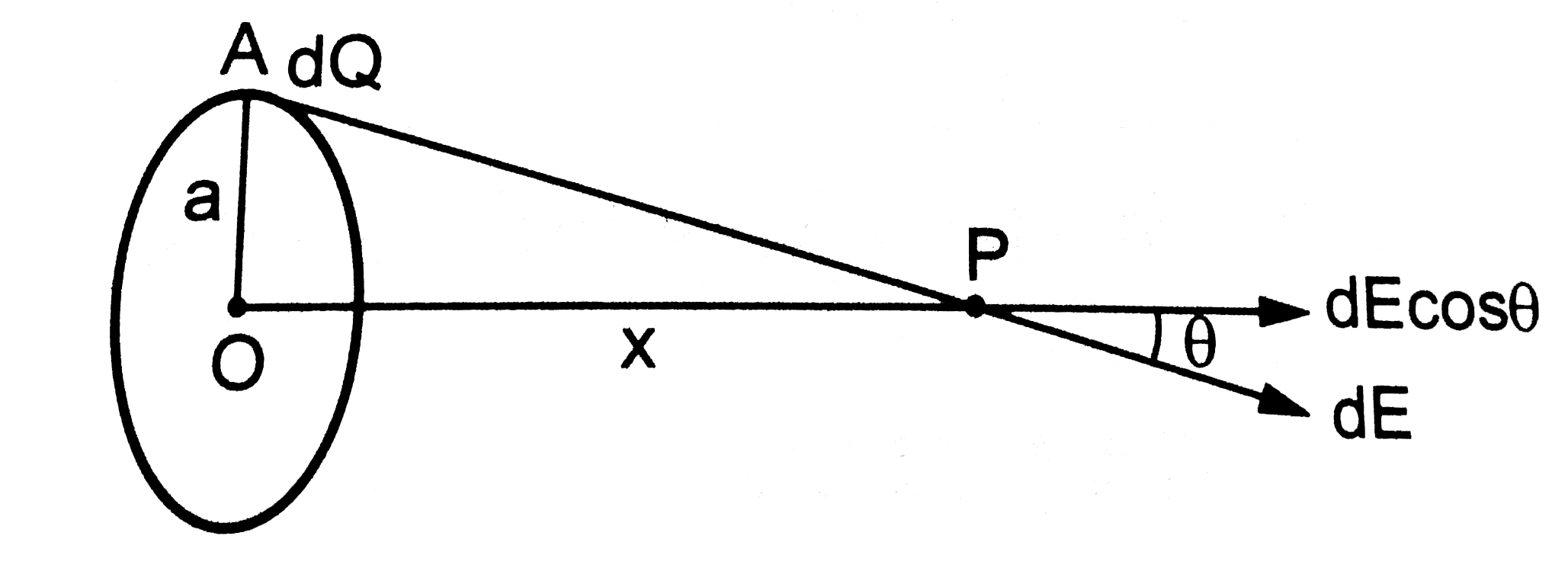A ring of radius a contains a charge q distributed. uniformly ober its length. Find the electric field at a point. on the axis of the ring at a distance x from the centre. Solution in Tamil

shows the situation. Let us consider a
. small element of the ring at the point A having a charge
. dQ. The field at P due to this element is
.
By symmmetry, the field at P will be along the exis OP
. The comonent of dE along this direction is.
The net field at P is
.
Topper's Solved these Questions
- ELECTRIC FIELD AND POTENTIALBOOK - HC VERMACHAPTER - ELECTRIC FIELD AND POTENTIALEXERCISE - worked out Examples
19 Videos
- ELECTRIC FIELD AND POTENTIALBOOK - HC VERMACHAPTER - ELECTRIC FIELD AND POTENTIALEXERCISE - question for short answer
14 Videos
- ELECTRIC CURRENT THROUGH GASESBOOK - HC VERMACHAPTER - ELECTRIC CURRENT THROUGH GASESEXERCISE - Exercise
23 Videos
- ELECTROMAGNETIC INDUCTIONBOOK - HC VERMACHAPTER - ELECTROMAGNETIC INDUCTIONEXERCISE - EXERCISE
98 Videos
Similar Questions
Charges 5.0×10−7C,−2.5×10−7Cand1.0×10−7C are
held fixed at the three corners A, B, C of equilateral triangle of side 10cm respectively. Find the electric force on the charge at C due to the rest two.
View SolutionThe charge on a proton is +1.6X10(−19)C and that on an
. electron is −1.6X10(−19)C. Does it mean that the electron
. has a charge 3.2X10(−19)c less than the charge of a
. proton?
View SolutionA discharge tube contains helium at a low pressure. A large potential difference is applied across the tube. Consider a helium atom that has just been ionized due to the detachment of an atomic electron. Find the ratio of the distance travelled by the free electron to that by the positive ion in a short time dt after the ionization.
View SolutionCalculate the dimensions of (a) ∫→E.d→l,(b)vBlanddΦ0dt. The symbols have their usual meanings.
View SolutionCharges q is uniformly distributed over a thin half ring of radius R. The electric field at the centre of the ring is
View SolutionA point charge q is located at the centre fo a thin ring of radius R with uniformly distributed charge -q , find the magnitude of the electric field strength vectro at the point lying on the axis of the ring at a distance x from its centre, if x gt gt R .
View SolutionThe electric field at the centre of a uniformly charged ring is zero. What is the electric field and potential at the centre of a half ring if the charge on it be Q and its radius be R?
View SolutionA charge Q is distributed uniformly on a ring of radius R as shown in the following diagrams. Find the electric potential at the centre O of the ring

View Solutionत्रिज्या R के एक वलय पर आवेश q एकसमान रूप से वितरित है। इसकी अक्ष पर केन्द्र से x दूरी पर स्थित बिन्दु पर विद्युत् क्षेत्र की तीव्रता ज्ञात कीजिए।
View SolutionR त्रिज्या के कुचालक पदार्थ से बने किसी आवेशित वृत्ताकर रिंग पर कुल आवेश Q एकसमान रूप से वितरित है | रिंग के अक्ष पर इसके केंद्र से x दुरी पर विद्युत - क्षेत्र ज्ञात करे |
View Solutionएक R त्रिज्या की पतली वलय पर Q आवेश एक समान रूप से वितरित है वलय की अक्ष पर केन्द्र से X दूरी पर स्थित बिन्दु विधुत क्षेत्र की तीव्रता ज्ञात कीजिए। प्राप्त परिणाम की प्रतिबंध x>>R के लिए विवेचना कीजिए।
View SolutionThe maximum electric field intensity on the axis of a uniformly charged ring of charge q and radius R is at a distance x from the centre of the ring.The value of x is
View SolutionElectric charge Q is uniformly distributed around a thin ring of radius a. find the potential a point P on the axis of the ring at a distance x from the centre of the ring .
View SolutionConsider a uniformly charged ring of radius R and total charge Q. What is the magnitude of maximum possible electric field intensity on the axis of ring? What is the distance of point from the centre of ring at which the electric field is maximum?
View SolutionCalculate distance of the point from the centre of a uniformly charged ring on its axis, where it electric field intensity becomes maximum.
View SolutionA ring of radius R has charge Q distributed uniformly on it. At a distance x (!=0) from centre on its axis. (consider axial points only)
View Solution
